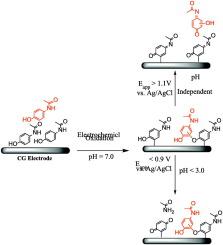当前位置:
X-MOL 学术
›
J. Electroanal. Chem.
›
论文详情
Our official English website, www.x-mol.net, welcomes your feedback! (Note: you will need to create a separate account there.)
Tunable oxidative release of N-acetyl-p-benzoquinone-imine and acetamide from electrochemically derived sub-monolayer acetaminophen modified glassy carbon electrode
Journal of Electroanalytical Chemistry ( IF 4.5 ) Pub Date : 2021-01-01 , DOI: 10.1016/j.jelechem.2020.114845 Hamid Salehzadeh
Journal of Electroanalytical Chemistry ( IF 4.5 ) Pub Date : 2021-01-01 , DOI: 10.1016/j.jelechem.2020.114845 Hamid Salehzadeh

|
Abstract In the present work, a glassy carbon electrode was electrochemically modified with acetaminophen. The mechanism of this modification along with the electrochemical features of the film derived from acetaminophen were investigated. In addition to cyclic voltammetry, the modified surface was subjected to analysis by XPS and ellipsometry. As anticipated for quinone/hydroquinone like structures, both the electrochemical modification process and the electrochemical behavior of the acetaminophen derivatized electrode are strongly potential and pH dependent. It was demonstrated that the voltammetric release of N-acetyl-p-benzoquinone-imine (NAPQI) and/or acetamide can be controlled through the applied potential and pH. The release of acetamide occurs after electrochemical oxidation of the acetaminophen derivatized electrode at a relatively low over-potentials followed by a hydrolysis reaction in acidic solutions. In comparison, NAPQI is released upon applying higher potentials, independent of pH.
中文翻译:

N-乙酰基-对苯醌-亚胺和乙酰胺从电化学衍生的亚单层对乙酰氨基酚修饰的玻碳电极的可调氧化释放
摘要 在目前的工作中,用对乙酰氨基酚对玻碳电极进行了电化学改性。研究了这种改性的机制以及源自对乙酰氨基酚的薄膜的电化学特性。除了循环伏安法外,还对改性表面进行了 XPS 和椭圆偏振法分析。正如对醌/氢醌类结构所预期的那样,电化学改性过程和对乙酰氨基酚衍生电极的电化学行为都具有很强的电位和 pH 依赖性。结果表明,N-乙酰基对苯醌亚胺 (NAPQI) 和/或乙酰胺的伏安释放可以通过施加的电位和 pH 值来控制。乙酰胺的释放发生在对乙酰氨基酚衍生电极在相对低的过电位下电化学氧化之后,然后在酸性溶液中发生水解反应。相比之下,NAPQI 在应用更高的电位时被释放,与 pH 无关。
更新日期:2021-01-01
中文翻译:

N-乙酰基-对苯醌-亚胺和乙酰胺从电化学衍生的亚单层对乙酰氨基酚修饰的玻碳电极的可调氧化释放
摘要 在目前的工作中,用对乙酰氨基酚对玻碳电极进行了电化学改性。研究了这种改性的机制以及源自对乙酰氨基酚的薄膜的电化学特性。除了循环伏安法外,还对改性表面进行了 XPS 和椭圆偏振法分析。正如对醌/氢醌类结构所预期的那样,电化学改性过程和对乙酰氨基酚衍生电极的电化学行为都具有很强的电位和 pH 依赖性。结果表明,N-乙酰基对苯醌亚胺 (NAPQI) 和/或乙酰胺的伏安释放可以通过施加的电位和 pH 值来控制。乙酰胺的释放发生在对乙酰氨基酚衍生电极在相对低的过电位下电化学氧化之后,然后在酸性溶液中发生水解反应。相比之下,NAPQI 在应用更高的电位时被释放,与 pH 无关。

























 京公网安备 11010802027423号
京公网安备 11010802027423号